SOME FAVOURITE MUSEUMS, GALLERIES AND SIGHTS IN AND AROUND NICE
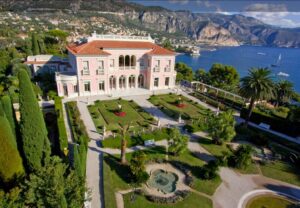
Nice has a wealth of sights and attractions, and we looked at some of them in the previous story. The enormous number of museums, galleries and great attractions in Nice and its immediate vicinity showcase everything from art to archaeological artefacts to Provençal perched villages. It’s a challenge to just restrict yourself to a few sights to take in during one visit, but that means there are plenty left on your list to draw you back for a future visit. Whether you’re interested in arts and culture or history, you can find it all in and around Nice. Even after many visits over some decades, we still discover new things to see.
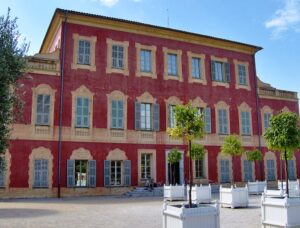
Probably the best-known art museum in Nice is the Musée Matisse. This lovely museum has an extensive collection of paintings, drawings, sculptures and photographs of, and by, Henri Matisse. The artist and his heirs donated many works to the museum, most of which were created when Matisse moved to Nice in 1917, and where he died in 1954. It’s now home to 68 paintings and gouaches, more than 200 drawings, over 200 prints, 57 sculptures and about 100 photographs. As well, there are around 200 personal objects of the artist, including ceramics, stained glass and documents.
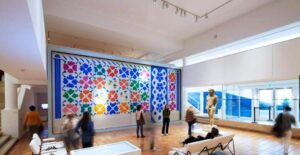
Although it’s not right in the heart of the city, the Musée Matisse is easy to get to. The Nice bus network is terrific. Bus no. 5, as well as a number of others, go up to Cimiez, the district where this museum is located, next to the Archaeological Museum of Nice-Cimiez (these shared the same building until 1989). Note that the museum is also close to the beautiful Cimiez Monastery, where Matisse is buried. The Museum is closed on Tuesdays.
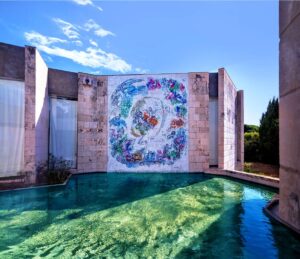
Not far from the Musée Matisse is the Musée National Marc Chagall, on Avenue du Docteur Menard. Take the same no. 5 bus, and like numerous others such as the Musée Matisse, it’s closed on Tuesdays. We’re huge fans of Chagall, and this museum bears witness to the great diversity of the painter’s works, including 12 paintings, and 105 engravings, their copperplates illustrating the biblical message from the books of the Old Testament series of 1966.
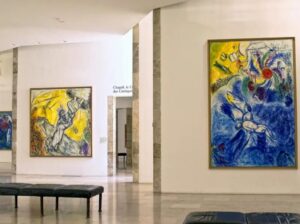
The collection includes paintings, drawings, prints, sculptures, ceramics as well as stained glass, tapestries and mosaics, which constitute a unique body of work where Chagall’s technical virtuosity, colourful inventiveness, together with his universal message of peace, are combined. The museum’s architect, André Hermant, had formerly worked with Le Corbusier, and was himself a member of the UAM, the French Union of Modern Artists.
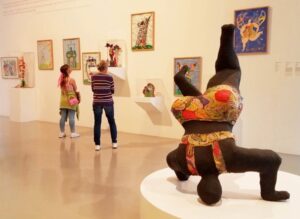
Located next to Place Garibaldi, just outside the Old Town, is the Museum of Modern and Contemporary Art (MAMAC). Inaugurated in 1990, this museum is a veritable treasure trove of art spanning from the 1950s to the present day, exploring areas such as European New Realism, the American expression of assemblage art, and Pop Art. The collection has around 1,400 works by 370 artists. Such artists include Christo, Yves Klein, Baldaccini, Deschamps, among other notables. The American Pop art collection includes works by Lichtenstein, Rosenquist and Andy Warhol.

The building itself is quite a landmark, and some say it’s the most imposing and iconic work of art at MAMAC. Designed by two architects, Yves Bayard and Henri Vidal, its monumental, distinctive shape, described as a tetrapod, straddles the course of the Paillon river, which now runs beneath the city’s main open plazas. The architecture of the building was inspired by neo-classicism rules, and its façades are covered with smooth, white Carrara marble. As well as their permanent collections, the museum often has very good temporary exhibitions, for example, from June until November 2024 the show is ‘Leger And The New Realism’. Entry is free.

The Musée Masséna is located in a prestigious late 19th century mansion at 65 rue de France, just behind the Negresco Hotel on the Promenade des Anglais. The villa was built by Victor Masséna, Prince of Essling and Duke of Rivoli in 1898. It’s said that the villa’s design was inspired by the Villa Rothschild in Cannes, but also the large Italian neo-classical villas that were becoming quite numerous along the Riviera at that time. It was transformed into an art museum in 1921 after Andre Masséna, Victor’s son, sold the villa to the city of Nice in 1919. The museum retraces the cultural and artistic influence of the French Riviera, or Côte d’Azur, from the annexation of Nice to France until the Belle Epoque.
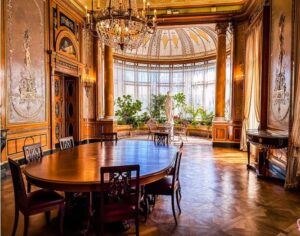
In a sumptuous setting, adorned with period furniture and decorative objects ranging from the Second Empire to the eve of WWl, it houses watercolours, oil paintings, engravings, sculpture, bronzes and posters. Two historically interesting exhibits are the death mask of Napoleon made by his doctor, and Josephine’s golden tiara, set with pearls, coloured gemstones and mother-of-pearl. Throughout your visit, you can explore the grand gallery, the library, dining room, grand salon and former reception rooms of the villa. The villa has regular temporary exhibitions, so worth checking either online or at the Nice Tourist Office.
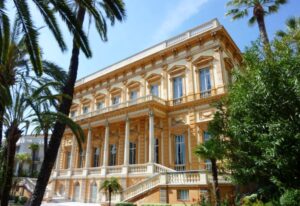
Musée des Beaux-Arts Jules Chéret (Fine Arts Museum) is housed in an elegant Italian Renaissance-inspired villa at 33 Ave. des Baumettes, which is a couple of blocks to the west of the Negresco on bus no. 38, stop: Chéret Museum, or it’s a 4-5 min. walk from stop Universitaire Méditerranée on the direct tram line no. 2 that runs from the city to the airport —ask the Tourist Office to mark these for you on a map.
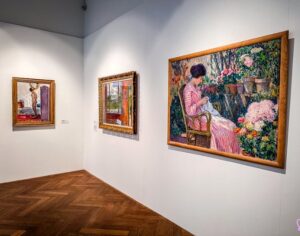
It has a remarkable collection spanning the history of art from the 16th to 20th centuries. In 1928 the museum occupied the former mansion built by a Ukrainian princess who was the wife of a private adviser to Tsar Alexander ll. It was later purchased by James Thompson, a wealthy American entomologist. Works include Impressionist and Post-Impressionist artists, Raoul Dufy (a great favourite of ours), Jules Chéret and Pierre Bonnard, among others. Note that it’s closed on Mondays.
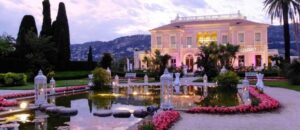
A couple of our favourite art museums and galleries aren’t right in Nice itself, such as the Villa and Gardens Ephrussi de Rothschild and Villa Kérylos, both of which I mentioned in the last story.
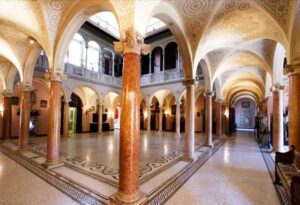
The Villa Ephrussi de Rothschild is located at Saint-Jean-Cap Ferrat, between Nice and Monaco, overlooking the Mediterranean. This magnificent, grand villa is surrounded by nine themed gardens: French, Spanish, Florentine, Japanese, a stone garden, an exotic garden, a rose garden and a Provençal garden. The villa and gardens were created by Baroness Béatrice Ephrussi, who was born a Rothschild and had married Maurice Ephrussi, a Parisian banker of Russian origin 15 years her senior, in 1883. She and Maurice divorced in 1904 mostly due to Maurice’s profligate lifestyle and compulsive gambling.
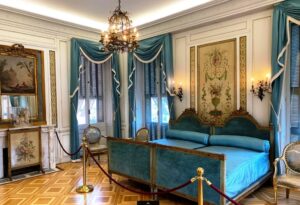
After the divorce, Béatrice turned her attention to one of her great passions: collecting art. She acquired a Tiepolo ceiling, 18th century furniture, a games table that had once belonged to Marie Antoinette, and a rug commissioned by Louis XIV. When her father died in 1905, she inherited his immense fortune. That same year, she decided to build her dream home in Cap Ferrat.
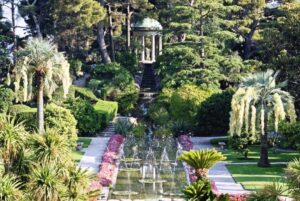
Work on the gardens began immediately and took 7 years to complete. The site chosen for the Villa was not particularly conducive to the creation of a garden due to poor soil on a rocky promontory exposed to strong winds. After rejecting plans from a couple of famous architects of the day, she finally chose Jacques-Marcel Auburtin as her architect for the Villa. She moved into it in 1912 and divided her time between Paris, Monaco and the Villa.
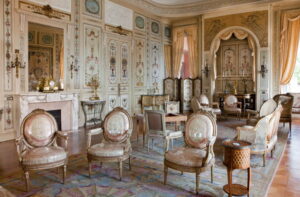
Béatrice made her Villa a haven for her art collections, with paintings by great masters, exquisite porcelain and furniture. It was the best of everything, if a rather eclectic mix. She died in Davos, Switzerland in 1934 from tuberculosis, and bequeathed her Villa and the entirety of its collection, which included over 5,000 works of art, and the 7 hectares of land, to the Académie des Beaux-Arts.
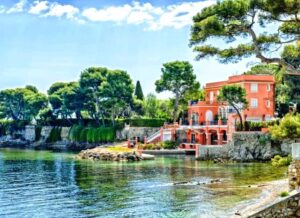
The area of St Jean-Cap Ferrat has long been renowned as a wealthy enclave of the rich and famous. On the other side of the Cap Ferrat peninsula, about 850m away from Villa Ephrussi-Rothschild, is a magnificent piece of architecture painted in a vibrant shade of pink, La Fleur Du Cap. This was built in 1880 as Villa Socoglio by the son of an arms dealer. This villa had many famous occupants, starting with the Duchess of Marlborough, the cousin by marriage of Winston Churchill, then Leopold lll, king of the Belgians, and after him, the great British actor, David Niven—the Villa’s location is now named Place David Niven. Charlie Chaplin once stayed for a week, and Grace Kelly and her husband Prince Ranier of Monaco, were also known to dine there often with their great friend Niven.
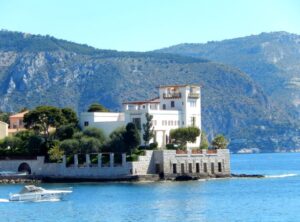
Barely 2 kms from Villa Ephrussi-Rothschild is the Villa Kérylos, right on the point of Beaulieu-sur-Mer. The no. 15 bus from Villa Ephrussi-Rothschild (or vice-versa) will take you there in about 10 mins. These buses run at around 8 min. intervals. Or you can walk between the two villas.
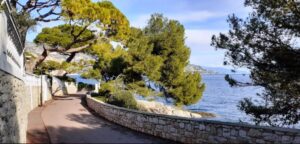
You could easily make a whole day out of visiting this part of the Riviera. There is a coastal path that connects the two small ports of Saint-Jean-Cap-Ferrat and Beaulieu-sur-Mer. It’s part of the 14 kms of coastal path around the Saint-Jean-Cap Ferrat peninsula, and goes past David Niven Square after about 1.4 kms from the start, along Promenade Maurice Rouvier, an easy walk, taking around 15 mins. However, it is more direct to walk from Villa Ephrussi de Rothschild to La Fleur du Cap, then on to Villa Kérylos. Ask at the Nice Tourist Office for details of all the wonderful walks in this area.
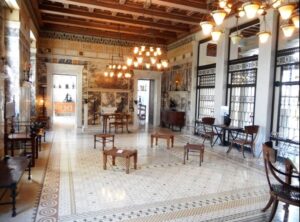
Villa Kérylos was designed and constructed between 1902 and 1908, as a collaboration between the archaeologist Theodore Reinarch and Emmanuel Pontremoli, an architect who had won the Grand Prix de Rome in 1890. The idea was to create an original work combining ancient luxury and modern comfort typical of the houses of the Belle Epoque. Reinach bequeathed the Villa Kérylos and its collections to the Institut de France before his death in 1928.
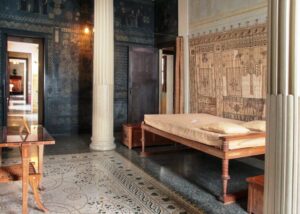
The villa is much more than a reproduction of a Hellenistic period villa, it’s a true “reinvention” of Ancient Greece, and just makes one want to travel to Greece immediately! The materials used for its construction were carefully selected from antique stuccoes, Carrara marbles, and exotic timbers for the furniture. In the various rooms the mosaics and frescoes depict classical gods and heroes and important moments in Greek myth and history.

Wall frescoes show the dispute of the lyre between Apollo, the god of the sun and protector of the arts, and Hermes, the messenger of the gods and protector of travellers; the death of Talos; the return of Apollo to the sanctuary of Delphi; the return of Hephaestus, the god of fire, forging and volcanoes, to Olympus Pelops, after whom the Peloponnese is named, and other mythical legends. There is a fine library specialising in archaeology as well as various objects. The upper floors reproduce various ancient, traditional functions as well as bedrooms for the owners, and display numerous fine antique objects d’art. The whole atmosphere is of a luxurious antique villa.
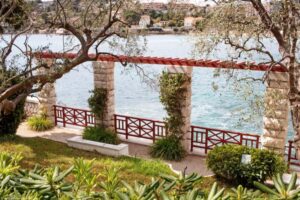
The view from the garden is magnificent, stretching as far as the Saint-Jean-Cap-Ferrat peninsula and its beautiful residences. The planting consists of olive trees, vines, pomegranate trees and oleanders, which thrive under the Riviera sun. The Villa Kérylos is open all year round although its opening times vary seasonally, so check with the Nice Tourist Office or go online to the villa’s own website. Entry fee is currently 13 Euros. As mentioned in the previous story, you can buy a combined ticket for the Villa Kérylos and Villa Ephrussi de Rothschild for 24 Euros.
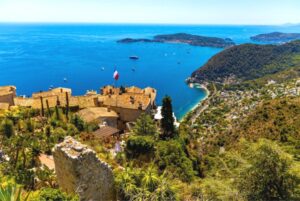
After visiting Villa Kérylos, consider heading to one of the most spectacular sights on the Riviera coast, the perched village of Èze, often described as an “eagle’s nest”. Take the no. 83 bus from Villa Kérylos, (the stop is simply called ‘Kérylos’). This bus starts at Baie des Formis at Beaulieu-sur-Mer, and goes past Villa Kérylos, and then takes you to Èze—the ride takes around 25 mins. From Èze it’s easy to take a bus direct back to Nice. Alternatively, out of Nice, take the no. 82 from Nice’s Vauban bus station, or perhaps more conveniently, Nice Boyer Station, to Èze village in about 30 mins.—the Tourist Office can show you stops in Nice that might be more convenient than going all the way up to the bus station. Don’t catch the no. 100, which goes to Èze sur Mer, unless you fancy a hike up the mountainside to the perched village. Èze’s bus stop is an easy walk to the medieval centre.

If you’re interested in gardens, the village has a well-regarded garden of tropical plants, the Jardin Exotique, you can visit. Established at the end of WW2, it was set out on the site of the ruins of a medieval fortress, perched 430 m. above the Mediterranean, so the views are breathtaking. The small village was founded around 2000 BCE, and a treasure trove of ancient Greek silver bowls dating from the 3rd century BC were found in Èze in the late 19th century. The Phoenicians had also occupied the site and erected a temple to the goddess Isis. The area was subsequently occupied by not only the Romans but also the Moors, who held the area for about 80 years until they were driven out by William of Provence in 973 CE.
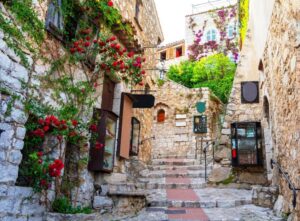
Today, Èze is famous for its beauty and charm, with many shops, art galleries, small hotels, restaurants that attract visitors and honeymooners, and a lovely Sunday morning market that showcases an array of local produce and handmade crafts. As a result, Èze has been dubbed by some a village-musée. Èze is one of 13 villages grouped together by the Communauté d’agglomération de Nice-Côte d’Azur tourist department as the Route des Villages. Ask at the Nice Tourist Office for more info. on the rest of the group, and also ask about the French Riviera Passes for entry to a number of museums, galleries and the Èze Jardin Exotique.
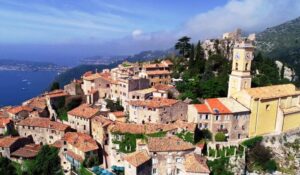
As I hope I’ve shown, Nice and its surrounds have a lot to offer the visitor, and I’ll save up more of these for the next story. Let me know if you’ve got any specific queries about this region, and I’d be delighted to try and help with some suggestions.
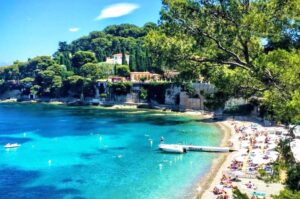


Looks wonderful. As always, a great read.
Many thanks Nadine! So glad you enjoyed it. Always so much to see and do in Nice–no time for just lolling about–we must try that when we’re next in Nice! Cheers, Cheryl
I have goofed off for a good 15 minutes reading and admiring the buildings and your wonderful knowledge of Nice — time to get fingers back to keyboard and do some work.
Hi Anna,
Well, we all deserve a bit of R ‘n R, especially when someone is as busy as I know you are! I can think of nowhere better than Nice to do that. As the saying goes: Nice is nice!! Cheers, Cheryl